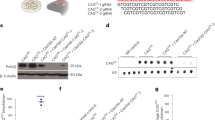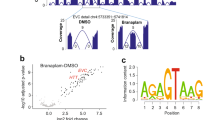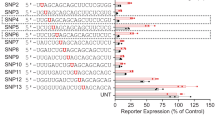Abstract
The dominant polyglutamine expansion diseases, which include spinocerebellar ataxia type 1 (SCA1) and Huntington disease, are progressive, untreatable, neurodegenerative disorders. In inducible mouse models of SCA1 and Huntington disease, repression of mutant allele expression improves disease phenotypes. Thus, therapies designed to inhibit expression of the mutant gene would be beneficial. Here we evaluate the ability of RNA interference (RNAi) to inhibit polyglutamine-induced neurodegeneration caused by mutant ataxin-1 in a mouse model of SCA1. Upon intracerebellar injection, recombinant adeno-associated virus (AAV) vectors expressing short hairpin RNAs profoundly improved motor coordination, restored cerebellar morphology and resolved characteristic ataxin-1 inclusions in Purkinje cells of SCA1 mice. Our data demonstrate in vivo the potential use of RNAi as therapy for dominant neurodegenerative disease.
This is a preview of subscription content, access via your institution
Access options
Subscribe to this journal
Receive 12 print issues and online access
$209.00 per year
only $17.42 per issue
Buy this article
- Purchase on Springer Link
- Instant access to full article PDF
Prices may be subject to local taxes which are calculated during checkout




Similar content being viewed by others
Accession codes
References
Orr, H.T. et al. Expansion of an unstable trinucleotide CAG repeat in spinocerebellar ataxia type 1. Nat. Genet. 4, 221–226 (1993).
Zoghbi, H.Y. & Orr, H.T. Spinocerebellar ataxia type 1. Semin. Cell Biol. 6, 29–35 (1995).
Skinner, P.J. et al. Ataxin-1 with an expanded glutamine tract alters nuclear matrix-associated structures. Nature 389, 971–234 (1997).
Fernandez-Funez, P. et al. Identification of genes that modify ataxin-1-induced neurodegeneration. Nature 408, 101–106 (2000).
Burright, E.N. et al. SCA1 transgenic mice: a model for neurodegeneration caused by an expanded CAG trinucleotide repeat. Cell 82, 937–948 (1995).
Klement, I.A. et al. Ataxin-1 nuclear localization and aggregation: role in polyglutamine-induced disease in SCA1 transgenic mice. Cell 95, 41–53 (1998).
Emamian, E.S. et al. Serine 776 of ataxin-1 is critical for polyglutamine-induced disease in SCA1 transgenic mice. Neuron 38, 375–387 (2003).
Chen, H.K. et al. Interaction of Akt-phosphorylated ataxin-1 with 14-3-3 mediates neurodegeneration in spinocerebellar ataxia type 1. Cell 113, 457–468 (2003).
Cummings, C.J. et al. Chaperone suppression of aggregation and altered subcellular proteasome localization imply protein misfolding in Sca1. Nat. Genet. 19, 148–154 (1998).
Caplen, N.J. et al. Rescue of polyglutamine-mediated cytotoxicity by double-stranded RNA-mediated RNA interference. Hum. Mol. Genet. 11, 175–184 (2002).
Miller, V.M. et al. Allele-specific silencing of dominant disease genes. Proc. Natl. Acad. Sci. USA 100, 7195–7200 (2003).
Xia, H., Mao, Q., Paulson, H.L. & Davidson, B.L. siRNA-mediated gene silencing in vitro and in vivo. Nat. Biotechnol. 20, 1006–1010 (2002).
Davidson, B.L. & Paulson, H.L. Molecular medicine for the brain: silencing disease genes with RNA interference. Lancet Neurol. 3, 145–149 (2004).
Pittman, R.N., Wang, S., DiBenedetto, A.J. & Mills, J.C. A system for characterizing cellular and molecular events in programmed neuronal cell death. J. Neurosci. 13, 3669–3680 (1993).
Kawasaki, H. & Taira, K. Short hairpin type of dsRNAs that are controlled by tRHAVal promoter significantly induce RNAi-mediated gene silencing in the cytoplasm of human cells. Nucleic Acids Res. 31, 700–707 (2003).
Clark, H.B. et al. Purkinje cell expression of a mutant allele of SCA1 in transgenic mice leads to disparate effects on motor behaviors, followed by a progressive cerebellar dysfunction and histological alterations. J. Neurosci. 17, 7385–7395 (1997).
Alisky, J. et al. Transduction of murine cerebellar neurons with recombinant FIV and AAV5 vectors. Neuroreport 11, 2669–2673 (2000).
Diener, H.-C. & Dichgans, J. Cerebellar and spinocerebellar gait disorders. in Clinical Disorders of Balance, Posture and Gait (eds. Bronstein, A.M., Brandt, T. & Woollacott, M.) 147–155 (Oxford University Press, 1996).
Stenoien, D.L., Mielke, M. & Mancini, M.A. Intranuclear ataxin1 inclusions contain both fast- and slow-exchanging components. Nat. Cell Biol. 4, 806–810 (2002).
Chai, Y., Shao, J., Miller, V.M., Williams, A. & Paulson, H.L. Live-cell imaging reveals divergent intracellular dynamics of polyglutamine disease proteins and supports a sequestration model of pathogenesis. Proc. Natl. Acad. Sci. USA 99, 9310–9315 (2002).
Khvorova, A., Reynolds, A. & Jayasena, S.D. Functional siRNAs and miRNAs exhibit strand bias. Cell 115, 505 (2003).
Reynolds, A. et al. Rational siRNA design for RNA interference. Nat. Biotechnol. 22, 326–330 (2004).
Urabe, M., Ding, C. & Kotin, R.M. Insect cells as a factory to produce adeno-associated virus type 2 vectors. Hum. Gene Ther. 13, 1935–1943 (2002).
Miyagishi, M. & Taira, K. U6 promoter-driven siRNAs with four uridine 3′ overhangs efficiently suppress targeted gene expression in mammalian cells. Nat. Biotechnol. 20, 497–500 (2002).
Williams, R.W. & Rakic, P. Three-dimensional counting: an accurate and direct method to estimate numbers of cells in sectioned material. J. Comp. Neurol. 278, 344–352 (1988).
Acknowledgements
We thank C. McLennan, J. Critchfield, S. Ries, N. Kiewiet and X. He for assistance. This work was supported by the National Institutes of Health (B.L.D., H.L.P. and H.T.O.), the Hereditary Disease Foundation (B.L.D., H.L.P. and S.Q.H.) and the Roy J. Carver Charitable Trust (B.L.D.).
Author information
Authors and Affiliations
Corresponding author
Ethics declarations
Competing interests
B.L.D. is a consultant for Sirna Therapeutics, Inc. and serves on the Scientific Advisory Board of Oxford BioMedica.
Supplementary information
Supplementary Fig. 1
Effects of shSCA1.F10mi and shSCA1.F11mi on ataxin-1 expression in mice cerebella. (PDF 125 kb)
Supplementary Fig. 2
Reductions in ataxin-1 inclusions in SCA1 mice requires transduction. (PDF 79 kb)
Rights and permissions
About this article
Cite this article
Xia, H., Mao, Q., Eliason, S. et al. RNAi suppresses polyglutamine-induced neurodegeneration in a model of spinocerebellar ataxia. Nat Med 10, 816–820 (2004). https://doi.org/10.1038/nm1076
Received:
Accepted:
Published:
Issue Date:
DOI: https://doi.org/10.1038/nm1076
This article is cited by
-
A clinical study and future prospects for bioactive compounds and semi-synthetic molecules in the therapies for Huntington's disease
Molecular Neurobiology (2024)
-
The potential value of disease-modifying therapy in patients with spinocerebellar ataxia type 1: an early health economic modeling study
Journal of Neurology (2023)
-
TR-FRET-Based Immunoassay to Measure Ataxin-2 as a Target Engagement Marker in Spinocerebellar Ataxia Type 2
Molecular Neurobiology (2023)
-
Toxicity after AAV delivery of RNAi expression constructs into nonhuman primate brain
Nature Medicine (2021)
-
Nuclear bodies formed by polyQ-ataxin-1 protein are liquid RNA/protein droplets with tunable dynamics
Scientific Reports (2020)



